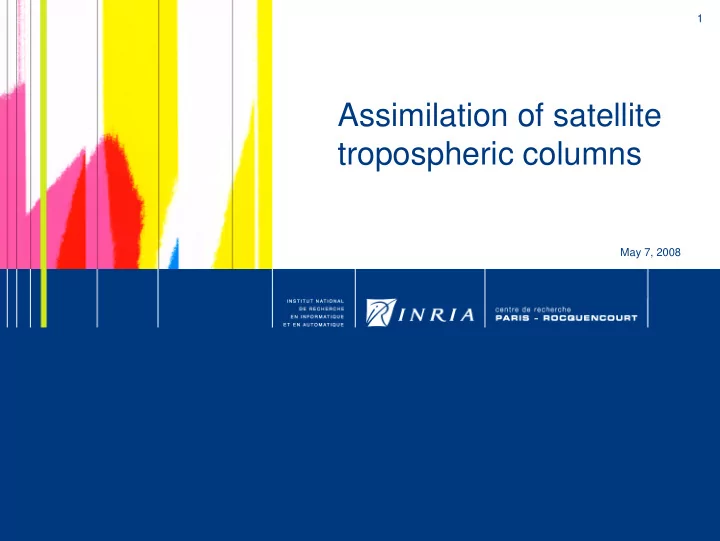

1 Assimilation of satellite tropospheric columns May 7, 2008
2 Pollution by satellite Pollution haze over China (Image from NASA) Striking visualizations of pollution (smog, plumes). Can this information be processed by air quality forecast systems?
3 Objective Aura satellite (NASA) • Application: air quality forecast at European scale. • Affected by high uncertainties (emissions, meteorological fields, chemical scheme). • Available data: air quality monitoring networks are irregularly scattered, of variable accuracy. • Availability of space-borne soundings of the troposphere: MOPITT, OMI (NASA), SCIAMACHY, GOME2, IASI (ESA). • Regular spatial sampling in clear sky conditions, daily revisit. • Tropospheric columns of trace gases (O3, NO2, CH4…), e.g. IASI provides 0- 6km O3 column, OMI 0-10km NO2 columns. • Aerosol optical properties. • Objective: to assimilate satellite columns to improve air quality forecast at ground level.
4 Context • ADOQA INRIA ARC (completed) on advanced data assimilation methods. • ESA/Eumetsat project on the feasibility of assimilating IASI columns for regional air quality forecast. • Participation to the TRAQ proposal for the future ESA tropospheric mission (around 2012). • Academic cooperation with IPSL/SA.
5 Information content • The tropospheric column is the total amount of a trace gas contained in a vertical column over a given area, up to: • Top of atmosphere: total columns, used for stratospheric studies, greenhouse gases and ozone hole monitoring. • Tropopause (12-16km): trans-continental transport. • Lower troposphere (6-10km): adapted to regional air quality. • Acquisition in the UV (GOME2, OMI) or IR (IASI) domains, then inversion of a radiative transfer model. Limitations: • Clear sky conditions (clouds may significantly lower the data availability). • High uncertainties especially for lower troposphere column. • Difficulty: the column provides a global information mixing all altitudes, air quality forecast requires accurate information in the boundary layer (first few km).
6 Simulated and measured NO2 column • Polyphemus (left) and OMI (right) NO2 column (0-500mb) on 2005, July 15th. • Comparison shows a good agreement in Western Europe (Ruhr, Benelux, UK), higher NO2 values measured by OMI on Eastern Europe
7 Tropospheric column/ boundary layer • Boundary layer ozone represents in average 14% of the 0-6km column. Left: average boundary layer contribution to the ozone column in summer and afternoon conditions (July 2001, 15h). • NO2 is much more concentrated at lowest levels. Right: typical NO2 profiles in non, moderately and highly polluted situations.
8 Model sensitivity • Numerical experiment with O3: • Perturbation of a reference O3 at t=0 above 1500m. • Comparison of Polyphemus simulation with/without perturbation. • The maximal impact on boundary layer is observed 27hrs after the perturbation, its amplitude is around one fourth of the initial perturbation. • A better knowledge of upper troposphere ozone (through assimilation of ozone columns) makes it possible to improve the boundary layer forecast.
9 Assimilation of simulated IASI columns • Twin experiment. Reference RTM Simulated Polyphemus Instrument model Inversion code IASI column Simulation Perturbation of input data Perturbated Assimilation Polyphemus Analysis Optimal Interpolation Simulation
10 Simulated IASI measurements The simulated measure is inverted Outgoing IR radiation as using SA-NN code, and compared measured by IASI (radiative to the reference column. The transfer using LBLRTM code, mean error is 27%, in agreement convolved with the instrument with IASI specifications (20-40%) model).
11 Assimilation of simulated IASI data • Perturbated run: • NO2 emission +30% • O3 deposition -15% • Boundary O3 +15% • Comparison of O3 columns: reference, perturbated, analysis • A1, A2, A3: assimilation, the analysis gets close to the reference. A3 • After A3, the analysis gets back closer to the perturbated run A2 A1
12 Assimilation of simulated IASI data • Comparison of O3 at ground level: reference, perturbated, analysis A2 A3 • A1, A2, A3: A1 assimilation, the analysis gets close to the reference. • After A3, the analysis gets back closer to the perturbated run
13 Conclusions • Feasibility study: IASI 0-6km O3 columns have the potential to improve air quality forecast at ground level. • Significant contribution of boundary layer O3 to the measure; • Good sensitivity of boundary layer O3 to a knowledge of upper troposphere ozone. • Positive assimilation experiments, even with simulated data. • Pending availability of IASI level 2 chemical data. • Ongoing: assimilation of real OMI NO2 columns. Differences: • Models are less good for NO2 than for O3 -> larger discrepancies between model and satellite data. • NO2 has shorter lifetime: can daily acquisition improve the forecast?
Recommend
More recommend